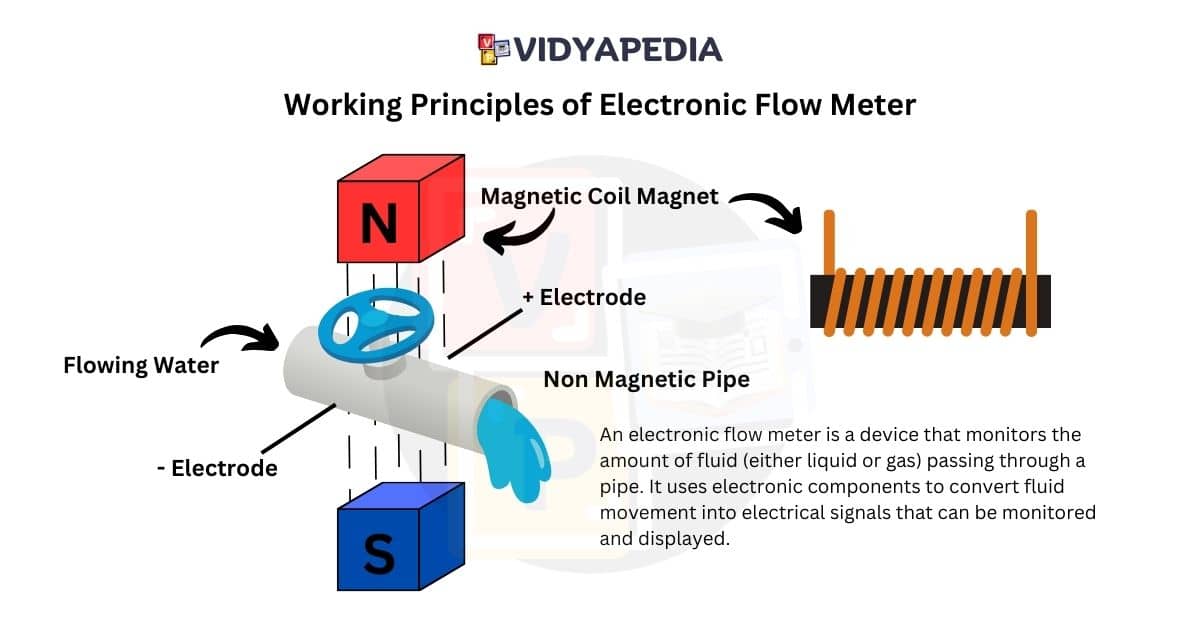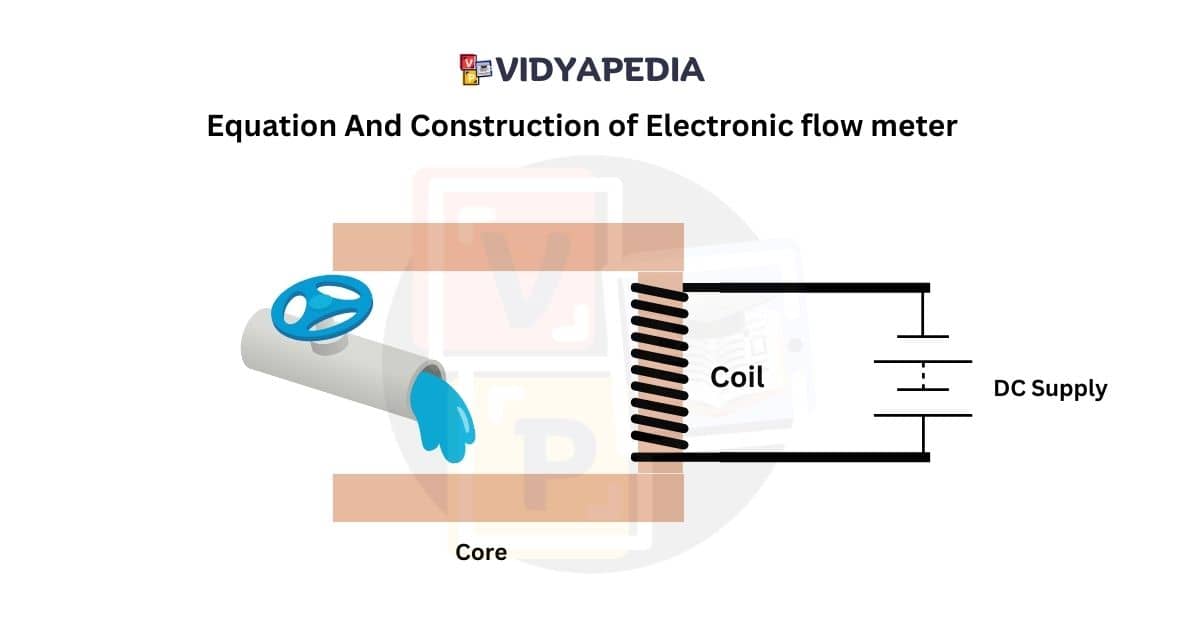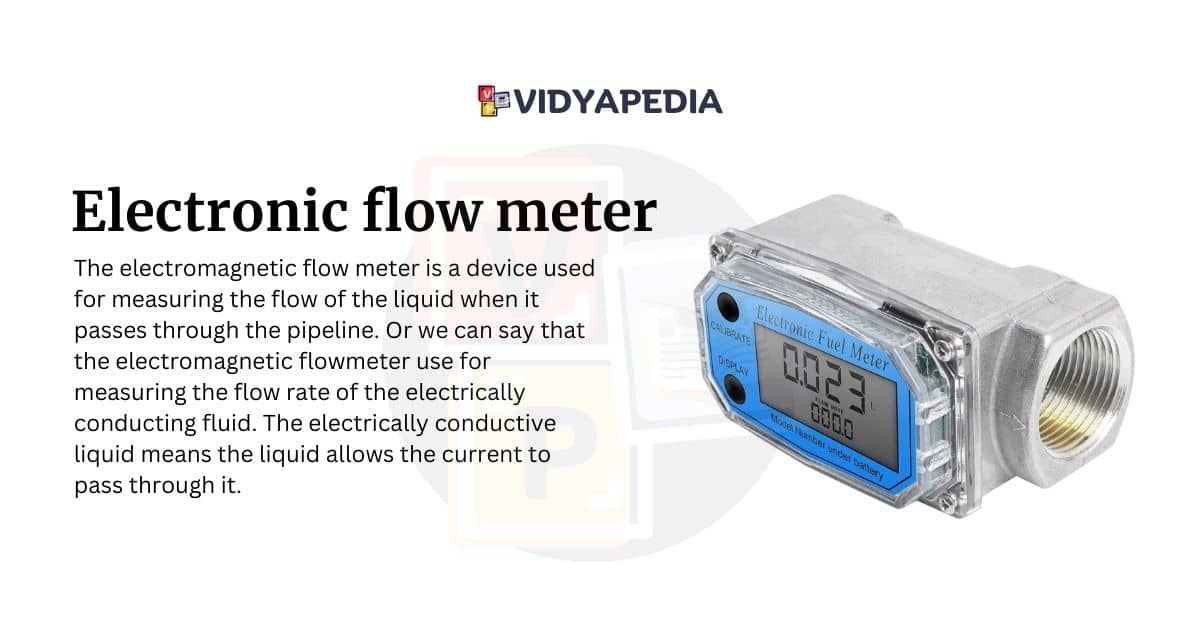An electronic flow meter is a device that monitors the amount of fluid (either liquid or gas) passing through a pipe. It uses electronic components to convert fluid movement into electrical signals that can be monitored and displayed.
This meter is also known as an electromagnetic flow meter because it works on the principle of electromagnetism.
Working Principles of Electronic Flow Meter

An electronic or electromagnetic flow meter measures the flow rate of a fluid using principles from physics involving electricity and magnetism.it is the principle of Faraday’s Law of electromagnetic induction It relies on the fact that when a conductive fluid flows through a magnetic field, it generates a small electric voltage. This voltage is proportional to the flow speed of the fluid.
How It Works
- Creating a Magnetic Field: Inside the flow meter, some components create a magnetic field. This magnetic field is set up perpendicular to the direction in which the fluid is flowing.
- Fluid Movement: As the conductive fluid (like water with ions) flows through the pipe and passes through this magnetic field, it interacts with the field lines.
- Inducing Voltage: A voltage is induced in the fluid because it is moving through a magnetic field. The faster the fluid flows, the higher the induced voltage.
- Measuring the Voltage: Electrodes are placed inside the pipe walls, perpendicular to both the magnetic field and the flow direction. These electrodes detect the induced voltage.
- Calculating Flow Rate: The induced voltage is directly proportional to the velocity of the fluid. By measuring this voltage, the flow meter can determine how fast the fluid is flowing. Knowing the pipe’s cross-sectional area, the device can calculate the volumetric flow rate, which is the volume of fluid passing through the pipe per unit of time.
Read Engineering
Equation of Electronic flow meter

The primary equation that describes the operation of an electronic flow meter is derived from Faraday’s Law of Electromagnetic Induction:
E=B⋅v⋅d\mathcal{E} = B \cdot v \cdot dE=B⋅v⋅dwhere:
- E is the induced voltage (volts).
- B is the magnetic field strength (Tesla, T).
- v is the velocity of the conductive fluid (meters per second, m/s).
- d is the distance between the electrodes (meters, m).
Explanation of the Equation
- Induced Voltage : This is the voltage generated in the fluid as it moves through the magnetic field. The voltage is directly proportional to the velocity of the fluid, the strength of the magnetic field, and the distance between the electrodes.
- Magnetic Field Strength (B): This represents how strong the magnetic field is. A stronger magnetic field induces a higher voltage for a given fluid velocity.
- Velocity of the Fluid (v): This is how fast the fluid is moving through the pipe. The faster the fluid moves, the higher the induced voltage.
- Distance Between Electrodes (d): This is the separation between the electrodes placed in the pipe. A greater distance between the electrodes results in a higher induced voltage for a given fluid velocity and magnetic field strength.
Calculating Flow Rate
The volumetric flow rate Q is related to the velocity v of the fluid and the cross-sectional area A of the pipe.
Q=A⋅vQ = A \cdot vQ=A⋅v
where:
- Q is the volumetric flow rate (cubic meters per second, m3/s).
- A is the cross-sectional area of the pipe (square meters, m2).
5 real-life applications of electronic flow meters:
- Water supply systems: Measure water distribution for accurate billing and leak detection.
- Irrigation systems: Monitor water flow to optimize crop watering and enhance yields.
- HVAC systems: Control coolant flow for maintaining optimal temperatures in buildings.
- Food and beverage industry: Measure liquid flow in production for quality control and mixing accuracy.
- Swimming pools: Monitor water flow in filtration systems to maintain clean and safe swimming conditions.
Advantages of electronic flow meters
- Accuracy: High precision in measuring flow rates.
- Wide Fluid Compatibility: Suitable for various types of fluids, including corrosive liquids and slurries.
- Low Maintenance: Fewer moving parts, reducing maintenance needs.
- Remote Monitoring: Capable of digital output and remote data collection.
- Versatility: applicable across different industries and environments.
Disadvantages of electronic flow meters
- Higher Initial Cost: Initial investment can be higher than mechanical flow meters.
- Installation Complexity: Requires careful installation and setup.
- Power Dependency: Relies on continuous power supply for operation.
- Complex Maintenance: May require specialized knowledge for calibration and upkeep.
- Fouling Potential: Susceptible to fouling, affecting accuracy over time.


